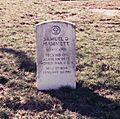Dashiell Hammett facts for kids
Quick facts for kids
Dashiell Hammett
|
|
|---|---|
| Born | Samuel Dashiell Hammett May 27, 1894 Saint Mary's County, Maryland, United States |
| Died | January 10, 1961 (aged 66) New York City, United States |
| Occupation | Novelist |
| Nationality | American |
| Period | 1929–1951 |
| Genre | Hardboiled crime fiction, detective fiction |
Samuel Dashiell Hammett (born May 27, 1894 – died January 10, 1961) was a famous American writer. He wrote many exciting crime fiction stories. He also wrote screenplays for movies and was involved in politics.
Hammett created some very well-known characters. These include Sam Spade from The Maltese Falcon. He also created Nick and Nora Charles from The Thin Man. Another famous character is the Continental Op from Red Harvest and The Dain Curse.
His books and stories had a big impact on movies. Many people think Hammett was one of the best mystery writers ever. Time magazine even put his 1929 book Red Harvest on a list. It was one of the 100 best English-language novels from 1923 to 2005.
Contents
Growing Up and Early Jobs
Hammett was born on a farm in St. Mary's County, Maryland. His parents were Richard Thomas Hammett and Anne Bond Dashiell. He grew up in Philadelphia and Baltimore.
He left school when he was 13 years old. Before becoming a writer, he had many different jobs. One of his most interesting jobs was working for the Pinkerton National Detective Agency. This was a famous detective agency. He worked there from 1915 to 1922.
Serving His Country
Hammett joined the United States Army in 1918 during World War I. While serving, he became very sick with the Spanish flu. Later, he got tuberculosis, a serious lung disease.
He spent most of his time in the Army recovering in a hospital. There, he met a nurse named Josephine Dolan. They later got married.
Family Life
Dashiell Hammett and Josephine Dolan had two daughters. Their names were Mary Jane (born in 1921) and Josephine (born in 1926). Because of Hammett's tuberculosis, he could not live with his family all the time.
Josephine rented a home in San Francisco. Hammett would visit them on weekends. Their marriage ended, but he continued to support his wife and daughters financially. He used the money he earned from his writing.
Becoming a Writer
Hammett used his experiences as a Pinkerton detective in his stories. He once said that all his characters were based on people he knew. This made his stories feel very real.
He wrote most of his detective stories in the 1920s. At that time, he was living in San Francisco. You can often find mentions of real streets and places in San Francisco in his books. His writing style is known as "hardboiled" crime fiction. This means the stories are tough, realistic, and often show the darker side of life.
Later Years and Activities
From 1931, Hammett had a long-term relationship with the famous playwright Lillian Hellman. Their relationship was even shown in a movie called Julia.
Hammett wrote his last novel in 1934. After that, he spent his life involved in political activities. He was strongly against fascism, which is a type of strict, controlling government. In 1937, he joined the American Communist Party. This was a political group that believed in a different way of organizing society.
In 1942, after the attack on Pearl Harbor, Hammett joined the United States Army again. Even though he had health problems from World War I, he was allowed to serve. He worked on an Army newspaper in the Aleutian Islands. He also developed emphysema, another lung condition.
After World War II, Hammett continued his political work. He became the president of the Civil Rights Congress in 1946. This group worked to protect people's rights.
In the 1950s, the U.S. Congress investigated him. This was during a time when Senator Joseph McCarthy was trying to find Communists in America. Hammett refused to share certain information. Because of this, he was put on a list called the Hollywood blacklist. This meant he could not work in Hollywood.
His Final Years

Hammett's health problems, including tuberculosis, got worse over time. In his last years, he became very private. He could no longer live alone, so he spent his last four years with Lillian Hellman.
Dashiell Hammett died on January 10, 1961, in New York City. He passed away from lung cancer. Because he was a veteran of two World Wars, he was buried in Arlington National Cemetery. This is a special cemetery for military members.
His Books
Here are some of the novels Dashiell Hammett wrote:
- Red Harvest (1929)
- The Dain Curse (1929)
- The Maltese Falcon (1930)
- The Glass Key (1931)
- The Thin Man (1934)
Short Stories
Hammett also wrote many short stories. Here are a few examples:
- "The Gatewood Caper" (1923)
- "Nightmare Town" (1924)
- "The House in Turk Street" (1924)
- "The Girl with the Silver Eyes" (1924)
- "The Gutting of Couffignal" (1925)
- "Fly Paper" (1929)
- "A Man Called Spade" (1932)
Other Works
- Creeps by Night; Chills and Thrills (1931; an anthology he edited)
- Secret Agent X-9 Book 1 (1934; a comic strip he wrote)
- The Battle of the Aleutians (1944; a text he wrote for the Army)
Images for kids
-
Lillian Hellman in 1935
-
Hammett's grave, in Arlington National Cemetery, (section 12, site 508)
See also
 In Spanish: Dashiell Hammett para niños
In Spanish: Dashiell Hammett para niños




